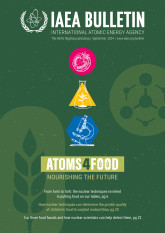
If you would like to learn more about the IAEA’s work, sign up for our weekly updates containing our most important news, multimedia and more.
Enhancing Mung Bean and Chickpea Cultivation in Pakistan Through Nuclear Techniques
Bernadette Hogg
Pulses such as chickpeas, mung beans and lentils are staples of Pakistani cuisine. While many countries are reliant on imports, Pakistan has achieved self-sufficiency in mung bean production thanks to nuclear science, and some farmers have doubled their yield.
Mung beans are high in protein and help to combat malnutrition. Most of the mung bean varieties grown by Pakistani farmers are developed by Pakistan’s Nuclear Institute for Agriculture and Biology (NIAB) in collaboration with the Joint Food and Agriculture Organization (FAO)/IAEA Centre of Nuclear Techniques in Food and Agriculture (Joint FAO/IAEA Centre). These new varieties have improved crops’ yield performance, resistance to disease and nutritional profile. The two varieties released in 2021 — NIAB Mung 2021 (NM-2021) and Abbas Mung — were grown on around 70 per cent of Pakistan’s mung bean acreage that year, contributing significantly to the country’s food security and economy.
While Abbas Mung is a medium sized seed variety known for its cooking quality, NM-2021 is a bold sized seed variety with increased nutritional quality. Hakim Ishfaq Mohy ud Din Chisti, a farmer from the Punjab province, praises NM-2021: “The yield of my crop was high. NIAB must continue its efforts to develop such varieties in future.” As NIAB mung bean varieties produce more than twice the yield per hectare than previous varieties, they could effectively double mung bean production, helping to address Pakistan’s food and nutritional needs.
Nuclear mutation breeding techniques, which have been applied since the 1930s to accelerate the process of developing and selecting valuable agronomic traits, use plants’ own genetic make-up to mimic the natural process of spontaneous mutation. The mutation process generates random genetic variations, resulting in mutant plants with new and useful traits.
In 2022, intense and deadly floods swamped two million acres of agricultural land, severely affecting the mung bean crop in Punjab and causing a shortfall. But Muhammad Jawad Asghar, principal scientist in the mung bean group within NIAB’s Plant Breeding and Genetics Division, is hopeful for the future of the mung bean crop in Pakistan: “This is not the end. This is an opportunity to do two things: remain self-sufficient and produce a surplus.”
Increasing chickpea yield and pest resistance
In addition to mung beans, chickpeas are a major ingredient in many Pakistani recipes. In 2021, Pakistan ranked as the world’s seventh largest producer of chickpeas by volume, but the country’s farmers had a low yield relative to the area cultivated.
NIAB’s chickpea group has been working on both Desi and Kabuli types. Desi types are typically flavourful and preferred by farmers, while Kabuli types are larger, lighter in colour and preferred by the younger generation, with many using them as a breakfast ingredient. Two-year evaluation studies have been completed on two new chickpea varieties that will soon be released for cultivation by the Punjab Seed Council.
NIAB is part of an ongoing IAEA coordinated research project (CRP) that aims to improve the tolerance of pulse crops to biotic stressors such as disease and insect pests using mutation breeding, a nuclear technique that speeds up plants’ natural evolution. Azeem Asad, principal scientist in NIAB’s chickpea group, says the CRP provides “valuable inputs and experiences in developing chickpea varieties tolerant to a pod borer, which were made possible through insightful collaborations with the Joint FAO/IAEA Centre and participants from around the world.” The pod borer in question — the cotton bollworm Helicoverpa armigera (Hübner) — is chickpea pest that causes severe damage by boring into growing pods.
Anupama J. Hingane, a plant breeder and geneticist at the Joint FAO/IAEA Centre’s Plant Breeding and Genetics Laboratory, says: “The results of the ongoing CRP open up the prospect of enhancing insect resistance in pulse crops using nuclear techniques. This breakthrough promises a sustainable solution to combat pests and protect pulse crop yields, which presents an opportunity that could revolutionize pulse crop cultivation.”
Continuing cooperation and improvement
In March 2023, the Punjab Seed Council approved PRI-NIAB Mung — a novel, versatile mung bean variety that matures more quickly — for commercial cultivation. In the future, NIAB hopes to increase mung bean tolerance to herbicides and insects. Within NIAB’s chickpea group, the focus has shifted to improving heat tolerance. With temperatures in February 2023 rivalling those of the summer months, developing heat-tolerant varieties has become increasingly important. A seed track-and-trace system was deployed in 2023, so the real impact of NIAB’s work will be more visible in years to come.
Pakistan is continuously strengthening and enhancing its capabilities for developing climate-smart crops and improving animal productivity and the management of soil, water and nutrient resources using nuclear and related techniques. Since 2022, the IAEA has planned and organized over 50 activities to support the country’s objectives.
______________________________________________________________________________________________________________
THE SCIENCE
Irradiating plant material
Used since the 1930s, plant breeding (also called evolution breeding) is the process of exposing plant seeds, cuttings or other planting material to radiation, such as X rays or gamma rays to create genetic diversity/variation. Induced irradiation causes changes in the DNA, mimicking the natural process of spontaneous genetic adaptation of plants to their changing environments. The individual plants exhibiting the desired traits are cultivated and multiplied so they can be distributed to farmers.
So far, over 3400 new varieties of more than 230 plant species have been developed using radiation-induced genetic variation and mutation breeding — including numerous food crops, ornamentals and trees used by farmers — in 75 countries.






